Notes on Alvin Weinberg's autobiography
By Nick Touran, Ph.D., P.E., 2019-07-29 , Reading time: 42 minutes
Alvin Weinberg was an original Manhattan Project scientist who dramatically influenced the development of nuclear energy. He’s a nuclear energy titan. In August, 2010, I purchased and read Alvin Weinberg’s autobiography, The First Nuclear Era.
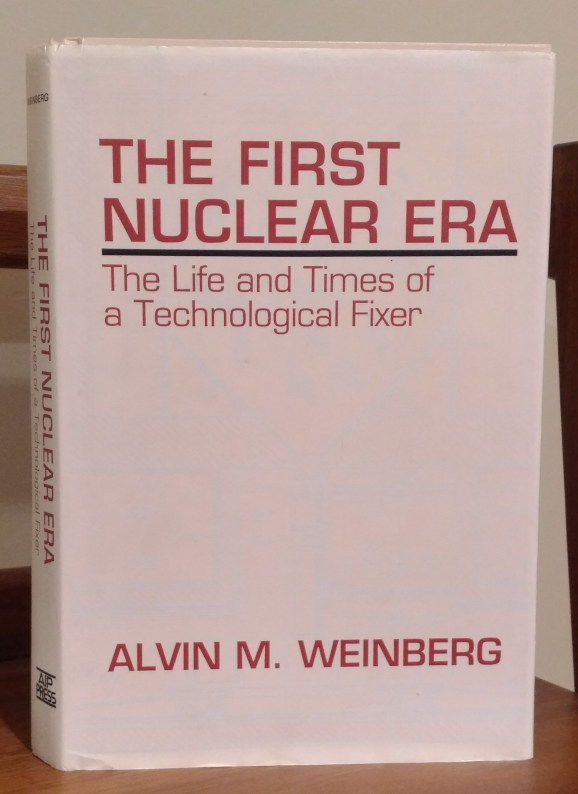
It so moved me that I wrote a 5-star review, which concluded:
It’s like he’s a guiding light, speaking to me about my passions from the grave. An eloquent writer, his book is not necessarily targeted towards engineers like myself, but would be very worthwhile to anyone interested in nuclear enterprise, or energy in general. I extremely highly recommend this to my peers and highly recommend it to everyone else.
Well, nearly a decade has come on gone since then, and I have matured into a not-so-young engineer with much more perspective than I had then. I decided to re-read it, and take notes this time. I present my notes here publicly with hope that the brilliance of Alvin Weinberg will live on and be read by even more people. I include some relevant hyperlinks in my notes to the various things he speaks of that I was able to track down.
Much of his biographical information is summarized on his Wikipedia page, so I will try to not repeat that information here. There are also 82 linear feet of boxes of Weinberg’s work at the University of Tennessee.
There’s also a more recent documentary about Alvin Weinberg’s life and work.
Chapter 1: Robert Hutchin’s University of Chicago
- 3 - Entrance to Univ of Chicago coincided with the University president’s New Plan, where in the first 2 years, all students took humanities, social science, biological sciences, and physical sciences and pass a 6-hour exam in each. He’s grateful for those years for the large survey of Western knowledge. Interestingly, Carl Sagan also expressed his “luck” in having studied under this philosophy.
- Became a synthetic thinker, rather than an analytic one.
- 5 - During depression, everyone was arguing amongst one another about the best course of action, eager to set things right.
- 6 - Worked under Eckart on quantum mechanical Hamiltonian for triatomic molecules like CO2 to understand things like IR absorption for his masters degree (e.g. the thing that causes climate change!). Here’s a paper they wrote.
- 7 - worked with Rashevsky on early Mathematical Biophysics (here’s his Ph.D. dissertation record).
- 8- Ph.D. work was on cell metabolism related to concentration gradients and diffusion. He learned the classical mathematical theory of diffusion here. This was why he got involved in pioneering the field of neutron diffusion theory (which is still used to this day to model the movement of neutrons in reactors).
- 10 - Eckart was W’s role model at least until he met Eugene Wigner…
Chapter 2: The Metallurgical Laboratory and Eugene Wigner’s Hanford
This chapter covers Weinberg’s time in the Manhattan Project, struggling to build reactors that could produce plutonium for the bomb.
-
12 - W showed Wigner his beryllium diffusion problems. Wigner understood deeply in minutes, suggested next few weeks of work. He says:
From my very first meeting I sensed that here was a theoretical physicist of an order I had never before encountered.”
- 15 - Fermi did a series of successive exponential piles with purer uranium and purer graphite. No one knew if a chain reaction with natural uranium was possible or not.
- 17 - W was assigned to compute the optimal lattice spacing, using mechanical Monroes, Marchants, and Fridens operated by junior staff
- 18 - Wigner directed them to study moderation by heavy water, light water, and beryllium. Heavy water was best but hard to come by, though easier to make than enriched uranium. Hitler used it with uranium cubes.
- 21 - W wishes he had been at the first critical reaction. Younger people should be allowed at such events so that history may live on longer. Sidenote, check out this 1967 film produced by Argonne about CP-1: The Day Tomorrow Began.
- 22 - For high powered Pu-producing reactors, Helium seemed like the natural coolant because it was neutron-transparent. Wigner worried: high temperature helium-cooling was an engineering nightmare: how to contain high-temperature fission products, put in large compressors, and remove plutonium without losing helium?
- Wigner was really concerned about Nazi progress and worked tirelessly as a result.
- 23 - Wigner proposed ordinary water coolant, with much confidence in his theoretical calculations. Would allow low temperature, low-pressure, no boiling. He prevailed and sketched out the plant in a report called CE-140 (which I’m unable to find online). I judge that this step alone, rooted in perceived reliability and simplicity, is what led more than anything to our water-cooled, water-moderated reactors that dominate industry today (these were water-cooled, graphite moderated reactors).
- 24 - Wigner ran bull sessions, laying out argument, listing pros and cons, hearing out opinions of all those present, and then making the final decisions for each design characteristic. I personally love this style of technical management.
- 25 - Since uranium was scarce, they designed Hanford reactors to be overmoderated, which made them unstable to water boiling, just as happened decades later at Chernobyl. The engineering contractor, DuPont, handled this with flow orifices to push any blockage out. Called it Boiling Disease.
- 26 - Complete 500 MW design published as CE-407. Design took 4 months. (Report may be reproduced here, though I have not gotten the PDF).
- 28 - Wigner hated that DuPont wanted to move slowly and check things and thought they had ulterior motives for later profit. But engineering and building a big reactor is difficult, and Wigner later apologized. DuPont saved Hanford by conservatively adding enough fuel tubes to compensate for the unexpected Xe-135 poisoning.
- 32 - Heavy water was code-named P-9. They investigated it in case other options failed. P-9 is such a good moderator that you don’t need to lump the uranium, you can just do a homogeneous mixture of uranium and heavy water. This sparked interest in fluid fuel reactors that lives on to this day (e.g. in Molten Salt Reactors).
- 33 - A small P-9 lattice pile was built in the Argonne forest at 300 kW called CP-3.
- 34 - Heavy water Pu-production reactors were built later, in 1953 at Savannah River. Earlier, a P-9 10 MW NRX reactor was built in Canada, sending them on the CANDU path
- 35 - X-10 reactor at what became ORNL was a small air-cooled 1 MW pilot to get enough Pu to shake down the separations chemistry before the big reactors at Hanford came online.
- 36 - X-10 produced enough Pu to understand Pu-240 and spontaneous fission, which would predetonate. Devastating news. Implosion bomb was designed that compressed much faster, but if that didn’t work, Wigner proposed using the Pu-240-tainted Plutonium in a converter reactor with Thorium-232, which would generate fissile Uranium-233, which could be used in a gun-type weapon. There was some uncertainty about the spontaneous fission of U-232, and also its alpha emissions causing (alpha, n) reactions in impurities like beryllium. In the end, the implosion design worked, and the thorium weapons path was not needed. But Wigner’s converter design was highly influential as the first heterogeneous plate-type highly enriched water cooled/moderated reactor. This foreshadows the submarine reactors and eventually modern LWRs.
- 39 - After Hanford was running, team turned to design power reactors. This was the first big
exploration of the different types of reactors that could be built. Lee Ohlinger minutes from the
New Piles Committee are apparently awesome. Good reads on the earliest reactor concepts. Try to
find!!! Breeder idea April 26, 1944. In 2004, ANS published some
info on the New Piles meetings including
some references. I have found many of the documents at the ORNL library
by searching for MUC-LAO in the report number. For example, this
one discusses some pretty wild reactors.
These are the first documented reactor brainstorming sessions.
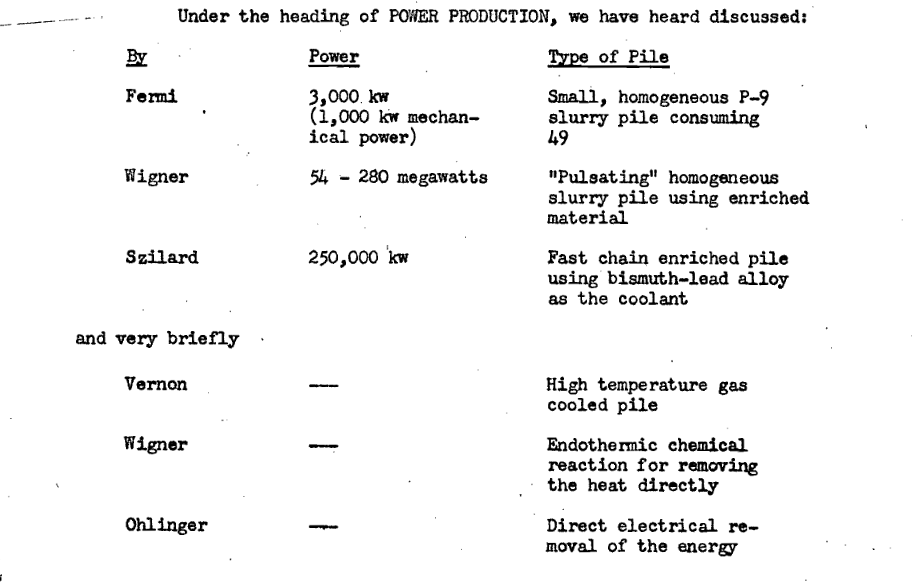
Some early reactor ideas from MUC-LAO-42 - 40 - Only a few thousand tons of uranium known. This (incorrect) assumption led to the push for breeder reactors early on, since it was thought that was the only way to make significant world-scale energy. As more uranium was discovered, this appears to this day to not be true, though in the long term, breeders are still needed to make nuclear truly sustainable/renewable on a ~billion-year timeframe.
- 41 - Fermi warned against proliferation and radiation first:
It is not clear that the public will accept an energy source that produces this much radioactivity and that can be subject to diversion of material for bombs.
- 41 - first pebble bed idea
- 44 - after the Battle of Bulge it was suggested by Zinn to put the Hanford radioactive waste in the way of the German tanks!!
Chapter 3: Clinton Laboratories — Where Man First Created Huge Quantities of Radioactivity
- 48 - W visited Gabon in 1976 making a documentary in nuclear energy. Find it! Shoot, I cannot find it. There was a natural nuclear reactor in Gabon 2 billion years ago, called Oklo. When the Earth was formed, natural uranium enrichment was above 20%!
- 50 - PWR could not be used to make plutonium but it could chain react with low enrichment. This yet again counters the myth that light-water moderated reactors were developed for military purposes.
- 52 - Navy interest in nuclear started really when Rickover came to ORNL’s school on reactors, called ORSORT.
- ORSORT was the prototype for nuclear engineering curriculum, and even had the senior reactor design project!
- Burnable poison was invented by one such design project to lengthen cycle length in remote operation
- 59 - Rickover preferred sodium coolant at first for submarines, for thermal efficiency reasons. Weinberg changed his mind to water because it’s simple and reliable.
- 61 - W thought Rickover had a poor understanding if the details, contrary to Rickover’s later writing.
- Rickover had a curious Jewish ghetto childhood and came off as someone who had nothing to lose.
- W Zinn apparently couldn’t work with Rickover for long
- 63 - occupational limit was 100 mrem/day back then.
- Mice were dosed to see dose response. Wonder how that worked out.
- 66 - The Bulletin of Atomic Scientists started with guys like Weinberg writing that civilians should control nuclear stuff, but later got captured by anti-nuclear activists and viewed nuclear as an abomination.
- 67 - ORNL in 1946 had poor scientific leadership,: the director did not know enough to have an idea where nuclear enterprise should go.
- 68 - AEC thought ANL under Zinn should do reactors and ORNL should do separations, isotopes, and waste. ORNL was sad to be left with garbage. They sang vulgar new year ditties about AEC f*ing them clearly.
- 69 - Maybe if ORNL chemical engineering had actually focused on nuclear waste issues, things would have worked out better in the end. Probably!
- 70 - Brookhaven was made close to NYC because it was thought that no good lab should be in the hills of Tennessee where there are no great universities or independent intellectual life!
- 71 - Weinberg accepted directorship on the condition that scientists could have more than the 2-week vacation allowed by the Carbide contractors at the time. Jesus, 2 weeks!
- 74- original PWR letter. They envisioned magnetic CR’s rather than vessel penetrations. Also considered thorium slurry PWRs. Nice. Here’s the citation, but no full copy online.
Chapter 4: Research Reactors: ORNL’s Scientific Centerpiece
- 76 - W considered ORNLs long-term goal to be the development of fluid fuel breeders.
- 78 - State of lab speech about how reactors are the only way the lab will survive. Labs must do horizontal reactor work. Leave vertical development (scaling up) to industry. Thus, the Homogeneous Reactor Experiment (a test of an Aqueous Homogeneous Reactor) was of utmost importance.
- 82 - The Materials Testing Reactor (MTR) was built at Idaho to test conditions needed for naval propulsion and central power, which started up in 1952.
- 84 - LITR was a mechanical mockup of MTR but they later loaded it with fuel and flowed water to see if there’d be any effect of moving moderator on the neutronics. There wasn’t.
- 85 - LITR was first observation of Cerenkov radiation. They sent a photo to
Scientific American and the AEC freaked in a “brouhaha”. Haha. It was on the
October 1951
cover.
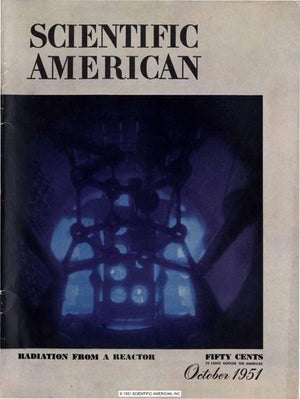
The Scientific American cover showing LITR Cerenkov radiation - 86 - Bulk Shielding Reactor (BSR) was MTR in a swimming pool for shield design of Nautilus and nuclear aircraft. It was done cheaply and was copied into hundreds of universities. The basis of the Swimming Pool Reactor
- Tower Shielding Facility (TSF) was like that but operated hoisted in the air
by 3 towers to see what radiation out of a plane would be like. Air forced
loved this kind of thing. Here’s a 46 MB report about it called: The Tower
Shielding Facility: Its glorious past.
Amazingly, the TSF doesn’t seem to have a Wikipedia page!? Here’s a more
recent blog post from ORNL about
it at least.
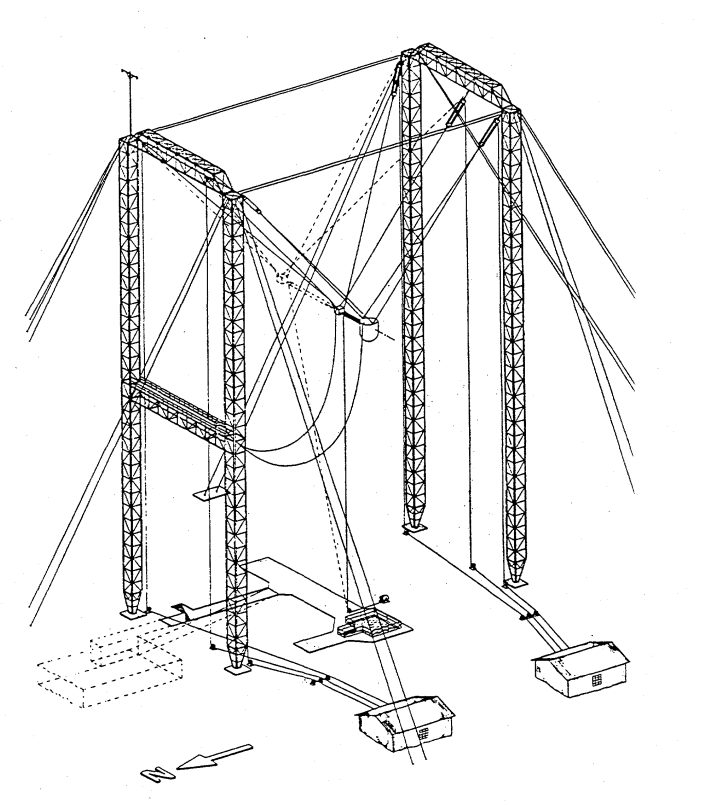
The Tower Shielding Facility at ORNL, where nuclear reactors were operated in the air (from link above) - 87 - a copy of the Bulk Shielding Facility (BSF) was built in 5 months in
Geneva for 1955 UN conference on Peaceful uses of Atomic energy. It was later
sold to Switzerland for $250k and operated at 10 MW for many years. People lined
up for hours to see it. Challenge was to make it 20% enriched instead of 93%.
Some nice photos of the entire exhibit and conference can be found in the 500
page US Delegation report. In
fact, many of the 15 volumes of proceedings from the conference are
available.
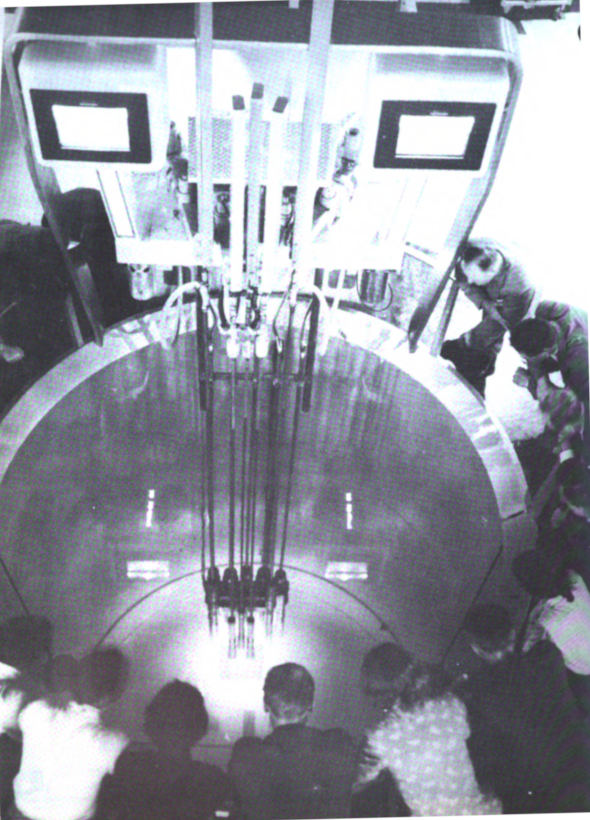
People viewing the reactor at the UN conference on Atoms for Peace (from delegation report)
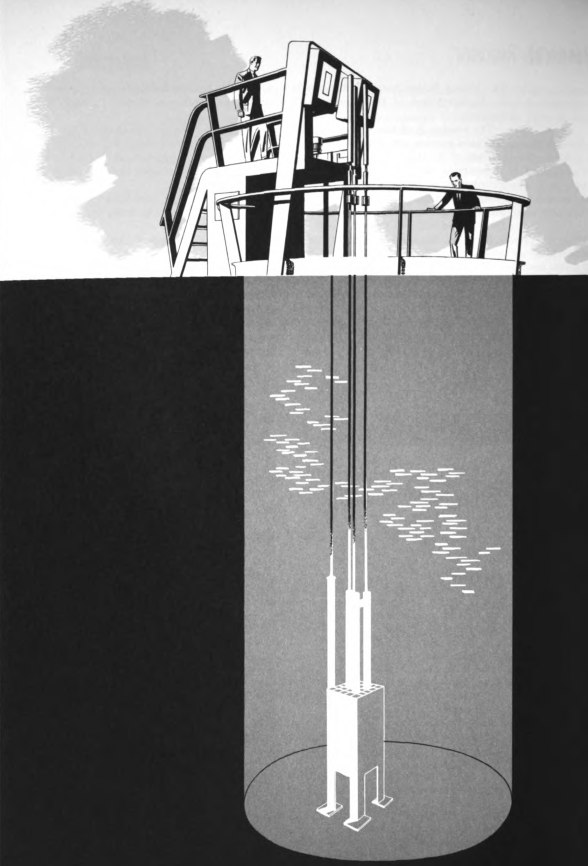
Schematic view of the Geneva reactor (from delegation report)
- 88 - ORR had confinement at negative pressure, not containment. Early use of term?
- 89 - Tom Cole did a maximum consequence report that was horrendous. W refused to release it because it had no mechanism. Today he’d be castigated, he thinks, but at least the low probability would be released too.
- 90 - HFIR was inspired by Seaborg’s desire to make CF252 and then irradiate it in accelerators to make heavier things. Apparently things that need two neutrons to reach get produced at a rate proportional to flux^2. 3 neutrons required: flux^3 and so on. Flux traps were made with beryllium where neutrons live much longer without getting absorbed. At MTR, flux was several times higher in flux traps than in the core.
- 94 - W was sad that the lab removed X-10 from its logo, Thinks maybe new scientists in the age of
nuclear disillusionment are less proud of the labs reactor history. He, however thinks research
reactors will always be the essence of the lab. Today, the ORNL logo is a damned oak leaf!
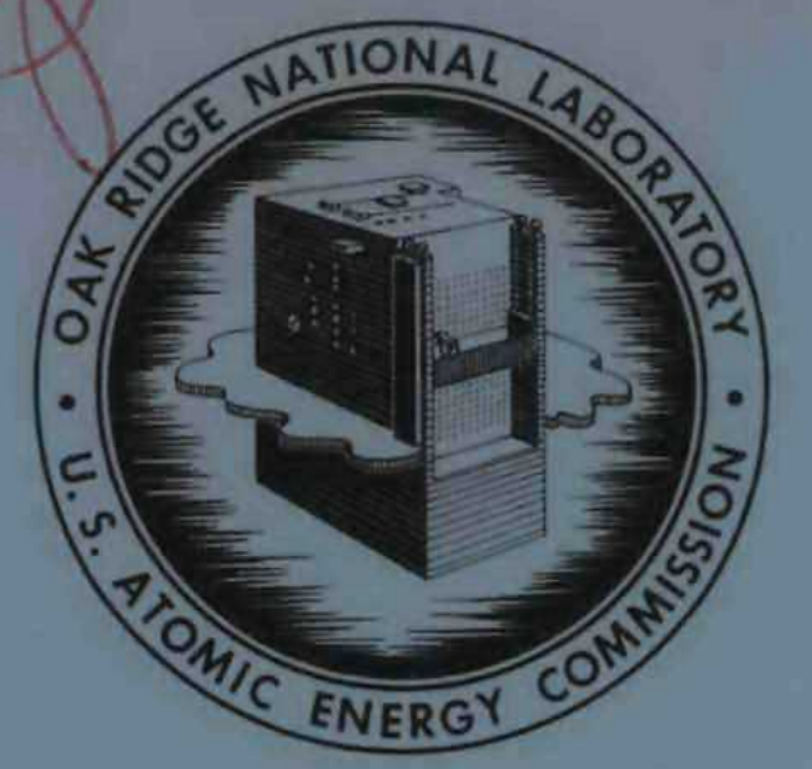
Chapter 5: Aircraft Nuclear Propulsion
Little do most people realize, the air force spent nearly $1B in the 1950s on getting nuclear powered long-range bombers. The eventual development of the ICBM eliminated the need for this.
- 96 - Oct 11 1945, Chicago tribune said “predicts atom will end limit on plane range.”
- 97 - engineers started thinking airplanes could work, partly because ICBMs were dreams in 1948, and partly because of “autocatalytic optimism”. (I love this term.)
- 100 - Aircraft Nuclear Propulsion high temperature reactors with solid fuel will come out looking like spaghetti. Ed Bettis came up with candidate: fluoride salts
- 102 - 6 years of systematic study of high temp materials, valves, pumps, and fluorides for and was one of the biggest contributions of ORNL. Funded for military needs.
- 104 - ARE was originally to be oxide fueled. But they changed to fluid. This was the first molten salt reactor (but not the first fluid-fuel reactor).
- It was setting alarms off all the time so they hooked a construction compressor to it and blew the radioactive gasses into the nearby forest. W suggested that some reactor design admin staff be on site so that they would subject themselves to the radiation they asked the operators to withstand
- after shutdown, pipe ruptured and control room dose rate went to 10 Roentgen/hour, 2000x background.
- 107 - (I wonder where the beautiful beryllium sphere is today from Aircraft Reactor Test? I can’t find any pictures.)
Chapter 6: Fluid-Fuel Power Breeders
- 109 - W got chided out for telling DoD that after a billion $ the ANP was unlikely to succeed. Soon after, JFK came in and canceled the program. Reactor people at ORNL accused W of treachery.
- 109 - Reactor development, like any heavy-engineering development, is an inverted pyramid: at the apex of the pyramid is the original idea, supported by theory and a few experiments; but as the chosen system becomes and engineering and then a commercial reality, the resources required to carry out the development increase greatly.
- 111 - GE worked on intermediate spectrum breeders
- 2nd nuclear electricity was from ORNL HRE homogeneous reactors experiment.
- 113 - GE converted their failed intermediate breeder into a sodium submarine reactor that powered the seawolf, but Rickover chose PWRs.
- 114 - Shippingport was based on aircraft carrier reactors
- Sodium was the favored tech for submarines due to efficiency at long range so Westinghouse got the second choice, PWRs, because GE had already started on sodium. Ha, that’s kind of ironic.
- 115 - W wanted labs to work on breeders, both SFR and fluid-fuel, because that was the long term, and GE/Westinghouse were doing fine in civilian development
- 116 - Aqueous Homogeneous Reactor (AHR) is just “a pot, a pipe, and a pump”. I think Thorcon uses similar terminology.
- 117 - You can separate solid fission products with centrifugal hydroclones.?
- Fluid fuel avoids control rods so they can’t be withdrawn to catastrophe.
- Maintenance may be difficult in locations where dose is lethal in minutes
- Could also use AHR for military plutonium production
- 118 - Froth collapse excursion is interesting. Sudden densification would increase reactivity a rapidly.
- 120 - Someone set up a silver plating device and made little medallions commemorating HRE-1. One was sent to Lise Meitner. Sounds badass…I want one.
- 121 - leaks at HRE low pressure side were a pain
- 122 - the guy on the control rod of CP-1 became the first articulate antinuclear advocate. George weil. (SCRAM guy)
- 123 George Felbeck (previously mentioned) was right: you must operate a reactor to understand it. Learned with HRE-2. This is an important lesson that current nuclear startups should heed.
- 124 - Patch in HRE-2 made with 20 ft tools miraculously. Dose rate 100,000 Roentgen/hr (500 R is lethal).
- 124 - Issue of breeding too important to be determined by guesswork or public opinion. Must be done by reactor experimentation. (Me: Ok but how to fund it?!)
- Three separate attempt of fluid breeders were under way when HRE-2 burned a hole in the ZR tank. AEC dropped AHRs.
- 125 - MSR adventure by MacPherson is what W uses to recollect MSR info
- AEC agreed that fluid breeders were important and told ORNL to proceed.
- Mac was a convert from ORSORT school
- Here is an incredible video about the Molten Salt Reactor Experiment
- 128 - burning rocks and sea paper, and case for breeding in nucleonics (Power Breeding as a National Objective, Nucleonics, vol 16, no 8, pp 75-6). (Sheesh, I can’t find anything about Nucleonics online. Someone please digitize!!). He also refers to Energy as the Ultimate Raw Material, which at least has a reference here
- 129 - admits dismissing solar as too expensive, though this may not always be the case.
- Lee Haworth projected 700 GW by 2000, motivating breeders more. Today, there are ~100 GWe of nuclear in the USA
-
130 - full concise view of why MSR was cancelled. Clear. SFR got in first, and MSR was considered too different. New and different technologies must both show that they are feasible and also convince influential people that they’re worth pursuing. Also, he hopes that MSR will be resurrected if weaknesses show in SFR. He’d be happy with the current state of affairs where multiple startups are working on various MSR manifestations.
Why didn’t the molten-salt system, so elegant and so well thought-out, prevail? I’ve already given the political reason: that the fast breeder arrived first and was therefore able to consolidate its political position within the AEC. But there was another, more technical reason. The molten-salt technology is entirely different from the technology of any other reactor. To the inexperienced, molten-salt technology is daunting. This certainly seemed to be Milton Shaw’s attitude toward molten salts — and he after all was director of reactor development at the AEC during the molten-salt development. Perhaps the moral to be drawn is that a technology that differs too much from existing technology has not one hurdle to overcome — to demonstrate its feasibility — but another even greater one — to convince influential individuals and organizations who are intellectually and emotionally attached to a different technology that they should adopt the new path. This, the molten-salt system could not do. It was a successful technology that was dropped because it was too different from the main lines of reactor development. But if weaknesses in other systems are eventually revealed, I hope that in a second nuclear era, the molten-salt technology will be resurrected.
Chapter 7: Economic Nuclear Power is Here?
- 133 - Ken Davis insisted that nukes must choose a single path and pushed LWR only
- 134 - Oyster creek, BWR for $129/kW. Euphoria. Economic nuclear power is here, W shouted, 1964.
- 135 - Extreme caution is necessary when one speaks of untried reactors. Great bible quote: he who is putting on his armor shouldn’t boast like he who is taking it off!
- Phil Hammond was fanatical about bigger being cheaper. Economies of scale.
- Jim Lampert, the Rickover of Army nuclear, proved that you don’t have to be a total bastard to head a successful reactor development. ORNL did preliminary design of Camp Century (see: this incredible video featuring Muckluck the dog) and McMurdo in Antarctica, and Ft. Belvoir. Too difficult and costly to maintain. Interestingly some military elements are showing interest in small nuclear reactors again.
- 138 - ORNL was tech consultant for the nuclear merchant ship NS Savannah. It operated, but was too expensive.
- 138 - Experimental Gas Cooled Reactor (EGCR) near ORNL was a response that the us should build a gas cooled reactor to see what the Brits liked so much.
- 140 - Blowers, valves, controls had to be tested and even designed. Doing it right on huge power reactors is much harder than MTR and hfir.
- By 1965 it got too expensive and was only 50%. Got canned. Bethel valley road: expensive mistakes.
- I found great reactor PDF with EGCR in it: An Account of Oak Ridge National Laboratory’s Thirteen Nuclear Reactors
- UK eventually largely abandoned AGR for PWRs in the end
Chapter 8: Desalting the Sea and other Technological Fixes
- 144 - JFK said we’d desalinate water and make electricity with tremendous nukes “before the decade is out (in 1963 here’s the quote:)
- 145 - Eisenhower plan was going to use nukes to make water for the Middle East and solve the Israeli-Arab conflict.
- 146 - They coined “nuclear powered agro-industrial complexes” – Detroit/Yale kids I spoke to once would have loved this.
-
147 - W gives Zinger to Rubin (soon PM of Israel) when asked if it was silly:
But Mr ambassador, is our drawing up of plans in Tennessee for agro industrial complexes for the middle east any sillier than Theodore Herzl’s drawing up of plans for Israel, in a Vienna cafe in 1896?
- By late 1960s, GE price list was proven way too low and LA’s dreams of 1.6 GW desal nearby went away. Prices were 3x GE list.
- 148 - W visualizes new technological society based almost entirely in electricity! Other industrial uses besides desal. Ammonia, gasoline from coal, iron, chlorine, aluminium, steel, acetylene. This is still a big topic as we shift from carbon-intensive fossil fuels for industrial process heat.
- 149 - dream published in foreign affairs, PNAS, and a book 1967: Reflections on Big Science. No more Malthusian dilemma. Prelude to HG Wells the world set free dream
- 150 - after speech, he heard mumbles of charlatanism and gross overoptimism from practical reactor developers. He had accepted impossibly low costs because he wanted to. It was only human, after making the bomb.
- 151 - social vs technological fixes and side effects. Social fixes can cause side effects too, like for instance Marxism. Hydrogen bomb was a Technical fix for a social problem that prevented WW3.
Chapter 9: International Euphoria
- 154 - Mentions German uranium lattice of cubes in a uranium bath with correct spacing. Thus, no secret, anyone can do it. W analyzed Nazi efforts soon after the war.
- 154 - W thinks French may consider chain reaction largely a French discovery.
- 156- Europe really in to nuclear because they mostly don’t have cheap fossil fuel like USA and Russia. After Suez crisis in 1956, things really picked up in Europe.
- 157 - Karl Wirtz of Germany had correct but slightly strained relations with other Europeans
- 158 - Best people were working on H bomb or went back to universities in US. In Europe, very good people were working more urgently on civilian npps. Rickover couldn’t tolerate Zinn, who was way smarter than Rickover. Karl Cohen and W Zinn were the best left going reactors in us.
- 158 - W went on nuclear Chautauqua’s, which means adult teaching sessions. Omg brilliant word.
- 159 - Kurchatov in USSR was the father of bomb and civilian programs, equivalent of Fermi, Oppenheimer, and Lawrence
- Weinberg met Feinberg in USSR (twr guy!?). Lots of laughs with names. Also Spitzer and Pitzer.
- Dollezhal was pushing steam cooled graphite moderated reactor. But oops Chernobyl happened 27 years after the visit.
- 160 - went out for a spin on Lenin, the nuclear ice breaker.
- 161 - E Nishibori in Japan hosted Weinberg in the beginning (1959). Was excited about molten salt. But his support never got too far as Japan built LWRs.
- sad: Anti-nuclear malaise was not in sight in Japan when w wrote this.
- 162 - preached Thorium-MSR mostly.
- 165 - Ralph Nader claimed that his antinuclear bias was a reaction to Weinberg’s optimism.
- Reactor in Yugoslavia was not in combat zone but worth worrying about.
- 167- Kanupp reactor in Pakistan operated poorly, illustrating that current NPPs are inappropriate for poor, technically unsophisticated countries
- 168 - Lewis Strauss conceived of atoms for peace and sold it to Eisenhower.
- 169 - Obninsk (called worlds first atomic power station) was a prototype RBMK
- 170 - 15 volumes of first international conference on the peaceful uses of atomic energy are a good handbook. Look up! (already did, see above)
- 171 - W and Wigner book written so the definitive book wouldn’t be of Russian origin! Mostly Wigner’s writing and scrutiny. Given out at Geneva II. Worldcat entry
- 173 - W laments that computer codes beat out classical analysis methods with Bessel functions and Legendre polynomials. Thinks real understanding and insight comes from classics. But self-aware that this breed is dying out.
Chapter 10: Nuclear Reality: The Faustian Bargain
- 175 - Lilienthal first went public with opposition to nuclear energy in 1963.
- Good framing of antinuclear sentiment.
-
176 - ANS paper has Faustian bargain
and then in a 1972 paper titled “Social Institutions and Nuclear Energy,” I first used the expression “Faustian bargain” to characterize nuclear energy: “We nuclear people have made a Faustian bargain with society. On the one hand we offer — in the catalytic nuclear burner (i.e., the breeder) — an inexhaustible source of energy. Even in the short range, when we use ordinary reactors, we offer energy that is cheaper than energy from fossil fuel. Moreover, this source of energy when properly handled is almost nonpolluting. Whereas fossil-fuel burners emit oxides of carbon, nitrogen, and sulfur … there is no intrinsic reason why nuclear systems must emit any pollutant except heat and traces of radioactivity.”
“But the price that we demand of society for this magical source is both a vigilance from and longevity of our social institutions that we are quite unaccustomed to.”
My characterization of nuclear energy as a Faustian bargain made me unpopular within the nuclear industry — but I became known among critics of nuclear energy as a sort of in-house conscience — a member of the nuclear community who was willing to voice doubts.
- 177 - W defends the regulator, says nuclear people weren’t addressing public concerns and regulator reflects public.
- Talk to Nader’s critical mass group was the worst. Cat calls. Shudder.
- 180 - says Libyans would send students to Oregon State University to learn how to do isotope separations. To OSU with Libyans in the class!
- Will UN respond to NK as it did to Iraq for proliferation? He hopes so.
- 181 - waste is less scary than reactors because of potential thermodynamic driving force.
- 182 - low dose effects are like witches, feared because you can’t prove they didn’t cause a leukemia.
- 183 - should have made waste design top priority of ORNL
- 186 - 1985, W wrote about carbon emission free energy for future generation justice. What a bad ass. Thinks we should build reactors that last forever given pressure vessel replacements and whatnot.
- 190 - Teller first made reactor safety central and established the ACRS.
- ACRS required Hanford w reactors to be rebuilt without positive void worth in 1947.
- Designers called it the New Piles Prevention Committee, begrudgingly
- 191 - NRX control rod in Canada was inadvertently pulled and released lots of radiation and evacuated the lab. Weinberg had a chill. Jimmy Carter went to clean up and got an anti-nuclear bias there.
- 192 - WASH-740 studied epic disaster. Withheld from public since no mechanism. W thinks in retrospect that’s a mistake (wait, didn’t he say he did the same at ORNL!?)
- 193 - Bill Ergen coined the China Syndrome for big reactors that could fail containment. Realization that containment could fail shifted strategy from saying reactors are totally safe to saying that the probability of catastrophe was low.
- 195 - we who work on nuclear energy are exercising our highest social responsibility when we study, understand, and remove dangers associated with nuclear energy (to alleviate population pressures).
- 196 - Epler asks what happens if BWR turbine trips, bubbles collapse, and CR’s don’t go in due to a common mode failure. What then!?
- 198 - Discussion of Milton Shaw. Rickover cloth. Like a bull. Student of ORSORT: neither best nor worst student.
- 199 - Chet Holifield gets mad at W and says it may be time for him to leave nuclear energy due to his work on reactor safety. Speechless. But defended by Floyd Culler. W and AEC lost lots of trust. Angry W had dinner with Ralph Nader after this. He’s not too proud but he also was pissed that AEC was being outrageous. The nuclear industry still does this to people who raise concerns in some cases.
Chapter 11: Smolny Institute on the Potomac
- W was fired soon after and was shocked. His wife had also died 3 years earlier. Sad. But in the end it was great that he was fired.
- 204 - in DC he popped Valium and walked on dangerous streets at night somewhat hoping to be jumped by some tough guy. Depressed. Sad.
- 208 - Project Independent Blueprint used econometric modeling on big computers. This raised cynicism in W for econometric modeling and policy making. This was part of Nixon’s Project Independence which notably reduced highway speed limits to 55 MPH. I believe this is one of the reports, but it doesn’t have a scan. W thinks the Project Blueprint thing was to distract people from Watergate.
- 209 - GE consultant said the first nuclear era was over in 1974 and economists expected US to be fine if it was abandoned altogether. W hoped a second era of breeders would come and last forever.
- 210 - put 10 breeders on each of 100 sites for 1000 reactors.
- W proposed that the government build a solar national lab, and it happened, as NREL!! Nice.
- 211 - suggested accessing western shale oil! Which later happened via fracking
- 212 - development of electric vehicle to reduce urban smog! Guesses correctly that they’ll get popular.
- Urged govt to pay attention to energy systems on climate!!!
- These recommendations, published in 1974, really show that Weinberg was ahead of his time. So wise.
- 214 - Became huge promoter of remarrying. Best thing ever for happiness. Convinced a dozen others to remarry.
Chapter 12: Energy Think Tankery
- 218 - RAND is a defense think tank, they wanted an energy one. High white house staff said they’d be the client, so they made one.
- W thinks establishing the language and categories of thought to be the most important step in policy. This very closely echos the concept of Ontology in information science
- They were embarking on systems analysis. Sounds like early systems engineering.
- W critical of systems analysis for very complex things like biology and cities. Thinks its fine for ICBMs. Use math where math makes sense to model interactions, but common sense elsewhere.
- 222 - at IEA they did an early net energy analysis in response to the idea
nuclear was net negative. A book came out in 1988 with many of their conclusions
called Net Energy Analysis, by Daniel
spreng.
Ethanol from corn came out worst. Nuclear was like 10x (only!?). Spreng wrote
this related document about
his time at IEA, which is actually really cool.
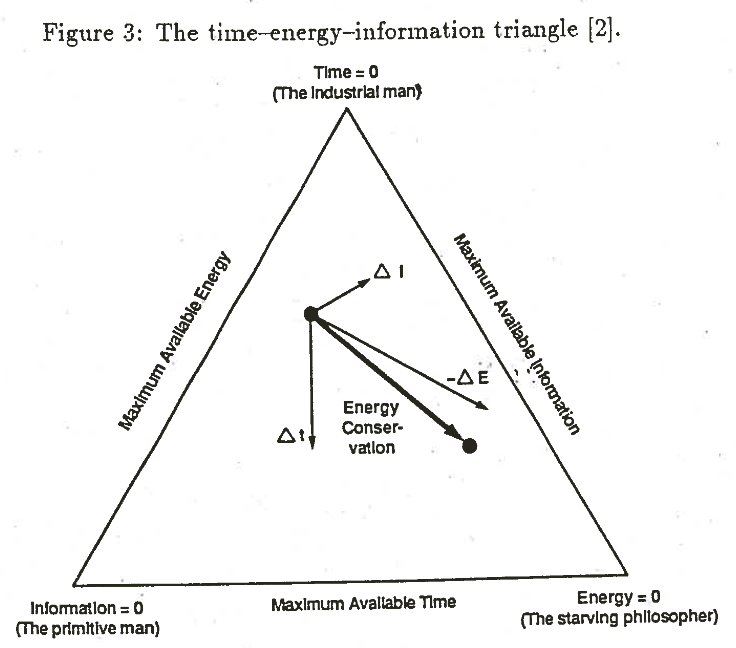
Time-Energy-Information Triangle that suggests energy lets you do things faster, and information may help you be more efficient. - 223 - In 1973 nuclear was faltering and people wanted the government to come in and save it. Carbon dioxide was just becoming a thing. Interestingly, this sounds a lot like what’s happening today. What’s old is new again!
- 224 - IEA study still said nuclear moratorium wouldn’t cause the us to freeze in the dark. Unpopular in the nuclear community, and W was disappointed too.
- 225 - So we should start thinking of nuclear systems that might be acceptable for all! Also a solar world.
- 226 - Solar doable with hydrogen or battery storage, just could be 3x more expensive. In the end it’s either solar or uranium or fusion. Or a combination. Responsibility to develop solar too for our children. Old nuke being pro-renewable is nice to see. I wonder how he’d take the current price trends, with solar PV falling from $350/kWh to $43/kWh in 10 years (LCOE w/o storage).
- 227 after TMI, W was skeptical of meltdown-proof reactors and wanted better institutions. Lilienthal wanted better reactors. Ironic. Lilienthal’s book is called Atomic Energy: A new start
- W said at a IEA workshop that drastic action was needed, that a meltdown was highly likely in the coming decades, not hurting anyone but bankrupting a utility and compromising the future of nuclear (Fukushima!) If not Chernobyl. Oh wait, this was before TMI! And general public utilities corp did go bankrupt.
- 228 - W wrote “Salvaging the atomic age” summarizing the IEAs ideas. Thinks inherently safe reactor is the most important.
- 230 - IEA had workshop with old nukes to think up new reactors. Group was skeptical that inherent safety could be done and also that it would change the public’s mind.
- 230 - did study anyway. GA HTR and PIUS PWR emerged as safest. PIUS had density lock of borated water that came down if anything heated up. W really liked it and envisioned a 2nd nuclear era with it. Report published in 1985 was largely ignored. Weinberg, The Second Nuclear ERA: A nuclear renaissance (1985)
-
231 - W explains concisely why LWRs dominate:
…pressurized water had been chosen to power submarines because such reactors are compact and simple. Their advent on land was entirely due to Rickover’s dominance in reactor development in the 1950’s’ and once established, the light-water reactor could not be displaced by a competing reactor.
- 232 - Italy shut down all nukes after Chernobyl.
-
again says Pius is best bet
In any case, the dominance of the existing vendors, Westinghouse and General Electric — not to speak of the French Framatome, German KWU, and the Japanese Hitachi and Toshiba — probably means that the next generation of reactors will incorporate relatively small improvements on existing types rather than drastically breaking with existing technology.
I would be somewhat disappointed were this to be the path of nuclear energy during the coming 25 years. Somewhere in the world there ought to be built a truly inherently safe reactor — probably a PIUS — so that we might know rather than guess whether such a device is feasible. To depend forever on reactors that fall short of this goal would mean doing less than we could or should do. Yet, on balance, I cannot complain too much. Although our second nuclear era study had little impact at the time it was issued, its message — that a second nuclear era ought to be based on reactors that are perceived as being safer than existing reactors — has now become more or less conventional wisdom.
- 233 - transparent safety is a term that means safety is readily understandable
- possibility that solar will be developed fast enough that fission is not needed.
- 235 - in 1975 he began carrying Keeling curves of COw rise around as justification for nuclear. Bob Seamans established a CO2 effects office at ERDA (predecessor to DOE)
- IEA focused on climate change for the next 8 years! Uncertain
- 236 - Gregg Maryland and Freeman Dyson publish paper saying 1 trillion trees per year could absorb all the CO2.
- In 1982, Bill Clark was in IEA and published carbon dioxide review and got a genius award and is a professor at Harvard.
- 239 - people prefer to use more energy to get places faster, possibly because we’re all mortal. Thus energy conservation is not primal
Chapter 13: Moonlight Philosophy
- 242 - Management’s function is to maintain standards and then to show that it cares.
- in 1955 suggested in Pittsburgh Natl labs focus on geoengineering and long term energy and resources needs. Basically as happened to a degree.
- 243 - atoms for peace and war 1953-61 sounds interesting re: ike vs generals
- 245 - coined term Big Science
- 247 - W considers his criteria for scientific choice to be one of the best ideas he’s ever had.
- collection of writing in this is in Reflections in Big Science, 1967. Used by NSF for judging proposals to some degree
- 249 - W worries that science could go as von Neumann worked about math (in The Mathematician), I.e. in unrelated directions of leas resistance where unrelated findings are published in isolation. Wanted a unified vision of value.
- 251 - Livermore scientists attacked nukes in 1960s regarding low dose radiation.
- nuclear reactions. : science and trans science , 1992, another paper by w
- 253 - W wrote in nucleonics about a flood of crappy nuclear books
- 255 - Govt should worry about scientific communication as well as funding science so it doesn’t waste its money on duplicate studies, etc.
- Science, government, and information SGI) made w an information guy. People were often surprised that it was the same Weinberg who convinced Rickover to go with LWRs.
Chapter 14: The Bomb
- 260 - discussion of using mutually assured survival instead of destruction is morally superior, with nuclear tipped ABM and civil defense, and a limit of offensive capability. Nike Zeus ABM
- 262- March 29 1983 star wars speech moved us toward MAS. Shades of Wigner and Teller!
- 263 - Imagined a defense-protected Build Down of nukes where reduced offense was balanced by defensive increase to ratchet down.
- 268 - W wonders if the marches and paper cranes at Hiroshima can transform it into a religious event, and whether or not that could help assure a permanent tradition of non-use of nuclear weapons. Terrorism is still the challenge here, and normal human nature.
- Perhaps Hiroshima was necessary to trigger the taboos surrounding further use of nuclear weaponry. Nagasaki was much more likely unnecessary, given more than 3 days delay.
- General Groves once told W that he alone was responsible for setting the early date of the Nagasaki bombing
- 270 - A 4-ton bonshoo bell now sits in the atrium of the Oak Ridge Municipal Building, like the one in Hiroshima that symbolizes the connection between the two cities.
Chapter 15: Could We Have Done Better?
-
The excitement of limitless energy led him:
No wonder that I more or less ignored the warnings of the early pessimists — that nuclear energy was far more difficult than we young enthusiasts imagined.
- 273 - James Conant (Roosevelt’s personal contact with Manhattan project) predicted in 1951 that nuclear would fail for Fermi’s reasons, and that solar would displace nuclear. Notably, Conant also didn’t believe for a long time that a chain reaction would ever be possible.
- 274 - W brought in Amory Lovins which led to his famous Foreign Affairs paper and launched his spectacular career on soft-energy paths
- W often conceded some main anti-nuclear points and became a token anti-nuclear nuke who admitted nuclear energy wasn’t without faults.
- 275 - Centralized societies like France let nuclear flourish, while federal countries like USA it faltered. Centralized democracies like France are Rousseauist and Jacobin where the elite implement the will of the people, whereas US is Jeffersonian with individual freedom and broad public participation.
- Nuclear system must be technically sound, but also “right” politically
- We know nuclear can be done right because of France and Japan, as well as Calbert Cliffs-1 and Oconee-3. (pre-fukushima)
- 277 - Commercial nukes descended from the submarine Nautilus, but super-containment or super-safety is irrelevant to a warship. Teller preached underground siting from the beginning, but adding that cost was and maybe still is out of the question.
- 278 - W was surprised by the public’s reaction to sequestered radiological wastes
- 279 - Nuclear energy needs fixing, not extirpation
- Way to convince public is to convince the skeptical elite. Pauh Erlich announced in 1989 to 1,500 students at Virginia Tech that he’d support nuclear if it was based on inherently safe tech because of greenhouse gas concerns.
- 280 - Sometimes feels like the old joke about the General who says he got his first medal by mistake and got the others because of the first one. But he stopped getting honorary degrees as nuclear fell from favor
-
281 - Goethe’s Faust was redeemed:
Who e’er aspiring struggles on, for him there is salvation
-
Final thought:
To deny a rebirth of nuclear energy is to deny human ingenuity and aspiration.